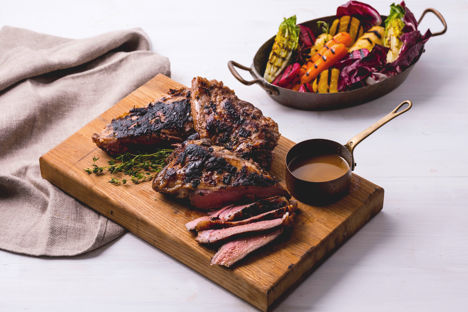Lamb is a very popular meat in the UK. For many, the ultimate roast is a leg of lamb with mint sauce or redcurrant jelly. A leg of lamb has a strong taste and can take robust spices, herbs and sauces. Diced up or minced, it’s fantastic in curries, tagines and pies.
What to look for when buying a leg of lamb
Always buy lamb from a decent butcher and opt for British and organic if you can. Keep in mind that the meat of grass-fed animals contains more omega-3 fatty acids than grain-fed ones. If choosing a rare breed of lamb it may be darker and taste more gamey.
When choosing lamb, look for a deep pink colour with dry, white fat.
Lamb should be stored covered in the fridge for 2–3 days or frozen on the day of purchase.
How to cook a leg of lamb
Leg of lamb is traditionally roasted in a hot oven (190˚C–220˚C) though it can also be slow cooked at lower temperatures for much longer. Lamb leg steaks are widely available for pan-frying and grilling and diced leg can be used for stews, tagines and pies.
When cooking a leg of lamb whole, don’t remove any excess fat – it adds flavour and helps keep the meat tender. The fat will render down during cooking; drain it from the roasting tray and whisk it into your gravy for an extra boost of lamb flavour.
It is important to let the meat come to room temperature before beginning to ensure it will cook through evenly. It is also imperative to let the meat rest after cooking, 20 minutes is sufficient. Wrap the leg in tin foil to prevent it from getting too cold.
Use a meat thermometer to test whether your meat is cooked or not; it’s not essential but will help determine to what stage the lamb is cooked, from rare (48–54˚C) to medium-rare (55–59 °C) to medium (60–66˚C) to well done (67–74˚C) and give a more consistent result. Roast lamb should be served pink in the middle. If overcooked, it is dry, chewy and unpleasant.
To decrease the cooking time, you can ask your butcher to remove the bone running down the middle of the leg, a technique known as butterflying. This is ideal for cooking on a barbecue. Try marinating the meat before cooking as Robert Thompson does in his recipe for Chargrilled leg of lamb with salsa verde and roasted beetroot.
Serving suggestions
Traditional flavour pairings for roast lamb are mint, rosemary, redcurrants, anchovies and garlic – see Andrew MacKenzie’s Roast leg of Welsh lamb with rosemary and anchovy or Shaun Rankin’s Roast leg of lamb with honey and minted Jersey Royals. Or try Andy Waters’ Moroccan lamb with fluffy cous cous or Anna Hansen’s Roast Baharat and lemon marinated Welsh lamb with sweet potato and fresh coriander.
Get in touch
Please sign in or register to send a comment to Great British Chefs.



